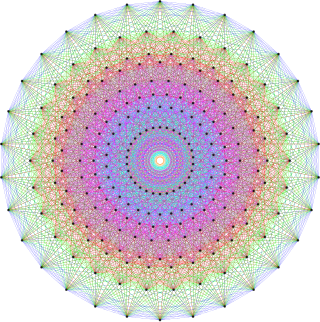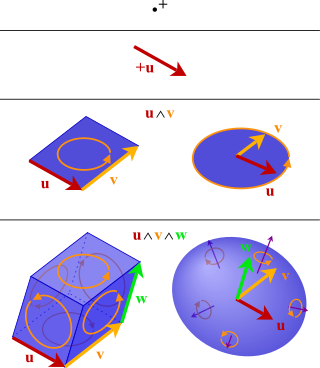Construction
C (V) may be constructed as a completion of the tensor coalgebra T(V) of V. For k∈N = {0, 1, 2, ...}, let TkV denote the k-fold tensor power of V:
with T0V = F, and T1V = V. Then T(V) is the direct sum of all TkV:
In addition to the graded algebra structure given by the tensor product isomorphisms TjV ⊗ TkV → Tj+kV for j, k∈N, T(V) has a graded coalgebra structure Δ : T(V) → T(V) ⊠ T(V) defined by extending
by linearity to all of T(V).
Here, the tensor product symbol ⊠ is used to indicate the tensor product used to define a coalgebra; it must not be confused with the tensor product ⊗, which is used to define the bilinear multiplication operator of the tensor algebra. The two act in different spaces, on different objects. Additional discussion of this point can be found in the tensor algebra article.
The sum above makes use of a short-hand trick, defining to be the unit in the field . For example, this short-hand trick gives, for the case of in the above sum, the result that
for . Similarly, for and , one gets
Note that there is no need to ever write as this is just plain-old scalar multiplication in the algebra; that is, one trivially has that
With the usual product this coproduct does not make T(V) into a bialgebra, but is instead dual to the algebra structure on T(V∗), where V∗ denotes the dual vector space of linear maps V → F. It can be turned into a bialgebra with the product where (i,j) denotes the binomial coefficient . This bialgebra is known as the divided power Hopf algebra. The product is dual to the coalgebra structure on T(V∗) which makes the tensor algebra a bialgebra.
Here an element of T(V) defines a linear form on T(V∗) using the nondegenerate pairings
induced by evaluation, and the duality between the coproduct on T(V) and the product on T(V∗) means that
This duality extends to a nondegenerate pairing
where
is the direct product of the tensor powers of V. (The direct sum T(V) is the subspace of the direct product for which only finitely many components are nonzero.) However, the coproduct Δ on T(V) only extends to a linear map
with values in the completed tensor product, which in this case is
and contains the tensor product as a proper subspace:
The completed tensor coalgebra C (V) is the largest subspace C satisfying
which exists because if C1 and C2 satisfiy these conditions, then so does their sum C1 + C2.
It turns out [1] that C (V) is the subspace of all representative elements:
Furthermore, by the finiteness principle for coalgebras, any f∈C (V) must belong to a finite-dimensional subcoalgebra of C (V). Using the duality pairing with T(V∗), it follows that f∈C (V) if and only if the kernel of f on T(V∗) contains a two-sided ideal of finite codimension. Equivalently,
is the union of annihilators I 0 of finite codimension ideals I in T(V∗), which are isomorphic to the duals of the finite-dimensional algebra quotients T(V∗)/I.
Example
When V = F, T(V∗) is the polynomial algebra F[t] in one variable t, and the direct product
may be identified with the vector space F[[τ]] of formal power series
in an indeterminate τ. The coproduct Δ on the subspace F[τ] is determined by
and C (V) is the largest subspace of F[[τ]] on which this extends to a coalgebra structure.
The duality F[[τ]]×F[t] → F is determined by τj(tk) = δjk so that
Putting t=τ−1, this is the constant term in the product of two formal Laurent series. Thus, given a polynomial p(t) with leading term tN, the formal Laurent series
is a formal power series for any j∈N, and annihilates the ideal I(p) generated by p for j < N. Since F[t]/I(p) has dimension N, these formal power series span the annihilator of I(p). Furthermore, they all belong to the localization of F[τ] at the ideal generated by τ, i.e., they have the form f(τ)/g(τ) where f and g are polynomials, and g has nonzero constant term. This is the space of rational functions in τ which are regular at zero. Conversely, any proper rational function annihilates an ideal of the form I(p).
Any nonzero ideal of F[t] is principal, with finite-dimensional quotient. Thus C (V) is the sum of the annihilators of the principal ideals I(p), i.e., the space of rational functions regular at zero.
































